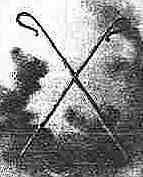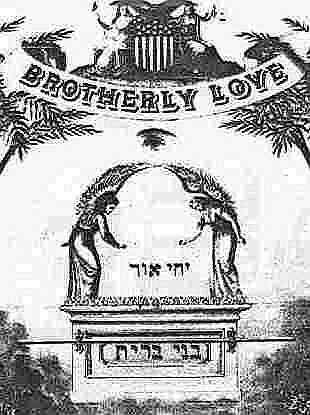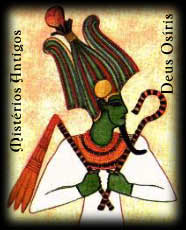





Note image of Goddess in center background and other Masonic Occult Symbology evident on this copy of the membership certificate. The "All Seeing Eye"(the big 'G') being pointed to by the Elder beside the young man who is making the sign of a Master Mason(right arm brought across the chest, left arm at side, posture indicating left leg at knee in reference to rolled up left trouser leg in initiation ceremony). The crossed shepherd crooks and keys refer to the Kabalistic concept of Tipereth which also can be symbolically represented by a truncated pyramid as on the back of the dollar bill (Tipereth is the concept of the dying and resurrecting god and is the centerpiece of being made a mason - the ritual death and rebirth ceremony which is part of all mystery religions and definitely a concept that is highly unorthodox - to say the least - in mainstream Judaism).
 The Story of a Covenant
The Story of a Covenant
The following material detailing B'nai B'rith's curious Masonic and Geopolitical History is taken from their official history book: B'nai B'rith - The Story of a Covenant, by Edward E. Grusd, Appleton-Century, New York 1966.
From the Forward pg. xi
Those whose responsiblity it is to interpret B'nai B'rith to the public have a formidable task... from small beginnings, has grown into a vast enterprise of nearly half million men, women, and young people in forty-four countries. It has become so complex in its structure and activities that most of its members-to say nothing of others-have only a limited knowledge of its achievements, purposes, and scope. This book, the first full-length history of B'nai B'rith,...
...From Chapter 2 - The very beginning
B'nai B'rith was founded on October 13, 1843, for the expressed purpose of ending, or at least reducing, the chaos and anarchy in Jewish life-or, as one of the founders put it, of "uniting and elevating the Sons of Abraham."
There were twelve founders, all in their twenties or thirties. All had been born in Germany, and had come to New York in the late 1820's or 1830's. All lived on the lower East Side, where most of them, at the time, were petty shopkeepers. The majority had not known one another in Germany, and only a few were acquainted before 1843...
Those few included Henry Jones, Isaac Rosenbourg, William Renau, and Reuben Rodacher. They met, apparently, because they were members of the Free Masons or Odd Fellows, as well as of several secret benevolent socities...
...There is a legend, which is occasionally mentioned to this day, that B'nai B'rith was founded because in 1843 Jews were barred from membership in the Masonic orders and the Odd Fellows. Obviously, that was not the case, since several of the Order's founders were themselves members of those organizations. We have fragments of memoirs written by Jones, Rosenbourg, and Renau, as well as by others who joined B'nai B'rith soon after it was founded, which leave no doubt about this...
...The Constitution created a supreme ruling body, called the Constitution Grand Lodge (CGL), which alone had the authority to issue and revoke charters for local lodges, frame laws binding upon all, confer degrees, and act as a final court in all disputes. It was to consist of the twelve founders plus the past presidents of all local lodges...
In line with their desire to have a Hebrew name for the group, they also chose Hebrew titles for their officers. The president was called the Grand Nsi Abh; the vice president, Grand Aleph; the secretary, Grand Sopher, etc. The ritual was similarly florid [masonic] it consisted of six degrees which imparted the aims and purposes of the Order, each illustrated by examples from Jewish history, thus imparting knowledge sadly lacking in most of the new members.[One of the general themes of the Occult is they imply to their potential recruits that they possess the "real" truth and the "full" and "complete" teaching of religion and history.]
To receive a lodge charter, twenty-five "Israelites" had to send in a petition and pay the expense of a CGL committee visit to determine if the group was worthy... Each lodge had to collect dues from its members... each lodge had to remit 10 percent of its receipts to the CGL, and pay twenty dollars for its charter. The Constitution designated New York City as the permanent seat of the CGL...
The Masonic "Home", at the corner of Oliver and Henry Streets, was rented for two dollars a night, and on Novemeber 12, at 8 P.M., the first meeting of the first B'nai B'rith lodge was called to order by Henry Jones as temporary chairman. It was named New York Lodge No. 1, and it is still flourishing. It was impressively installed, with all the founders of the Order present, not only as the supreme ruling body, but as members of the lodge. Full of solemnity, they conducted for the first time the imposing ceremonies prescribed by the ritual , which preumably captivated the imagination of all present.
The new group grew fairly rapidly. At each meeting there were from 20 to 25 applications for membership, although an average of four out of every ten were blackballed.
All fraternal bodies of the time were secret ones. Each new B'nai B'rith member was admonished "to hear, to see, and to keep silent." This aura of mystery intrigued them and welded them more closely together in a solemn brotherhood[The real secret to the occults power over the minds of men.].
New York Lodge was innocent of what is now known as membership promotion[what masons call "Placement" i.e. it's not numbers that count but where the "brother" works - cops and government officials being more useful than working class drones], but it began to attract some outstanding men, like Baruch Rothschild, who was later...
On the Founding of the ADL, on page 140.
Many people readily believed that all Jews were rich, contrary to the evidence of their own eyes; others, that all Jews were poor, and therefor "anarchists"; and some, that all Jews were usurers, trickey, and dishonest. Many otherwise kind-hearted people laughed cruelly when any of these Jewish steriotypes was portraryed on the stage or in cartoons or books. When they met a Jew whose family had been in America for several generations, they called him an exception.
It was therefore not surprising that, at the 1908 meeting of the Order's Executive Committee, Rabbi Joseph Silverman of New York proposed that B'nai B'rith should establish an agency "for the defense of the Jewish name", to do something about the "stage Jew," and even about such things as the study of Shakespeare's Merchant of Venice in public schools [George Orwell?]. It was not until five years later that B'nai B'rith did just that by founding its Anti-Defamation League, but long before it set up that agency it was engaged in such work. In 1908, for instance, Adolf Krause wrote to Melville E. Stone, head of the Associated Press, which became famous in view of Mr. Stones reply: "If A.B. a non-Jew, committs a crime, the Associated Press dispatches furnish the public with the news without any reference as to whether he is a Methodist, a Catholic, or whatever Christian denomination. If, however, A.B. happens to be a Jew, then almost invariably the news item informs us that A.B., a Jew, committed an offense. Is there any good reason for making such a distinction?
So the task the ADL set for itself was a twofold one: to fight overt expressions of anti-Semitism, and to educate the public, so far as possible, to the truth about the Jews. Actually the word "fight" is too strong a term for its early efforts. The approach to an editor, a public speaker, a theater manager, a businessman, or anyone else who had held up the Jew to ridicule was quiet, private, polite. There were no Jewish demonstrations, picket lines, threats, or boycotts, or even public exposures. The ADL representatives always gave the offender the benefit of any doubt.
When an offender became a backslider, the ADL contacted him again, and that usually closed the case. When he was defiant, other methods had to be used. Sometimes the man had business associates or friends who were willing to help him see the light. When a "Jewish comedian" refused to alter an insulting act, the ADL appealed to the theater manager. There was no boycott. But Jews soon hear about such things, and they are very sensitive, and that affects box-office sales. In some cases, of course, nothing availed, and the ADL had to admit failure.
In the summer of 1914, the outbreak of World War I was followed by a new series of pogroms. In London the B'nai B'rith lodge established a hostel for Jewish war refugees.
Soon after the war began, B'nai B'rith's Executive Committee began to discuss what might be done to bring postwar protection and equal rights to the Jews in eastern Europe. As in most wars, people generally, indulging in wishful thinking, assumed the conflict would soon be over. Nor did any forsee the Bolshevik Revolution and its profound effects on the Jewish masses. As early as the end of 1914, therefore, B'nai B'rith leaders began to formulate demands for civil, social, and religious rights for Jews, to be presented to the peace conference, no matter who the winner.
The United States was not in the war, and public sentiment was by no means all hostile to Germany. Millions of American citizens were of German descent, the Czar was universally hated, and it was not until the U-boat attacks on American ships that sentiment changed. B'nai B'rith was able to maintain fairly normal mail contact with European lodges.
In Germany the members, like German Jews generally, were fervently patriotic. Practically all the young members were in the Armed Forces, and the lodges made significant contributions to the war effort. The most dramatic was sponsorship of a huge railroad train which made regular trips to various parts of the front, delivering doctors, nurses, medical supplies, special foods, and other items to the German troops.
Meanwhile, in the United States, the demands made upon the Order were unending. In 1911, the Jewish section of Constantinople was destroyed by fire, and the CGL raised more than 23,000 francs for the victims. The Balkans were another source of tragedy for Jewish civilians.
The 1915 Convention therefore created a permanent Emergency Relief Fund, by assessing every member a given sum per year as part of his dues. The convention also, for the first time, set the Order's age minimum at twenty-one; before, each District had set its own.
But the most significant action taken by the convention was its decision to end its system of taxing every member a given sum per year for the support of charitable institutions. Instead, the Executive Committee was empowered to appropriate annually to such institutions amounts it thought proper. This was actually the beginning of the end of philanthrophy as a major program of the Order, although it still remains a minor one. The Convention Committee on Propaganda put it this way:
Union in Israel cannot be founded upon charity and philanthropy... The supreme altruism of the Order is deeper and more profound; far greater is the power within the Order to create of the Order a center of vital forces which shall ultimately evolve a complete freedom for Israel... Our duty in the largest interpretation of propaganda must be to make of the Jew today the Jew of history, and of the old historic ideals.(page 156)B'nai B'rith was not the only agency, early in World War I, that hoped the peace conference might bring a better life for the tragedy-ridden Jews in eastern Europe. Early in 1915 there arose two major factions in American Jewish life dedicated to the same idea. One of them, which included the American Jewish Committee, the UAHC, and other important groups, wanted a representative conference to discuss how Jewish rights might best be secured; the other, which included the Zionist Organization and bodies sympathetic to it, wanted an American Jewish Congress.
The first meeting of the Congress's Executive Committee took place in New York on Christmas, 1916. Immediately there was a clash. Adolf Kraus and Louis Marshall were nominated for temporary chairman, with Mr. Kraus winning, 49 to 45. He was chosen for permanent chairman by the nominating committee, but Cyrus L. Sulzberger nominated Mr. Marshall, his fellow leader of the American Jewish Committee. In doing so, he said Mr. Kraus was head of a "secret organization" [B'nai B'rith] and that that would be injurious to the Congress.
Mr. Sulzberger had been a member of a B'nai B'rith lodge in New York which had been suspended for violating the Order's rules, and he knew B'nai B'rith was not really a secret organization. Mr. Kraus replied calmly, "It is well known that B'nai B'rith is not a secret organization in the sense sought to be given it here by the minority spokesman. The Order has no secrets objectionable to any government on earth...





In 2000 it was reported that Mr. Abraham H. Foxman, ADL National Director, was working with the Grand Master of Anglo-American Freemasonry HRH The Duke of Kent, the founder of the Jerusalem Lodge, Grand Master of the Grand Orient of Italy Count Giuliano di Bernardo, and the Worshipful Master of the prestigious Quatuor Coronati Research Lodge Lord Northhampton, who has been atop the Temple Mount conducting 'studies'. Evidently these mystical adepts intend to reconstruct the 2,500 year old King Solomons Temple. It seems the brethren are anticipating a forthcoming resurrection of Grand Master Abiff's architectural endevours...

